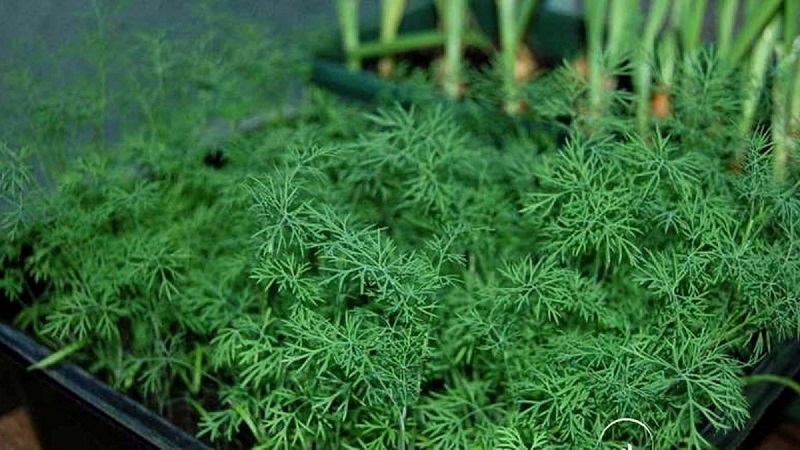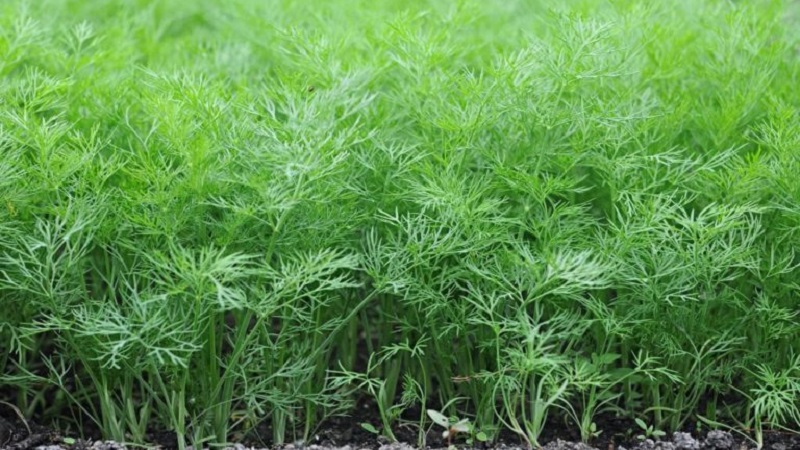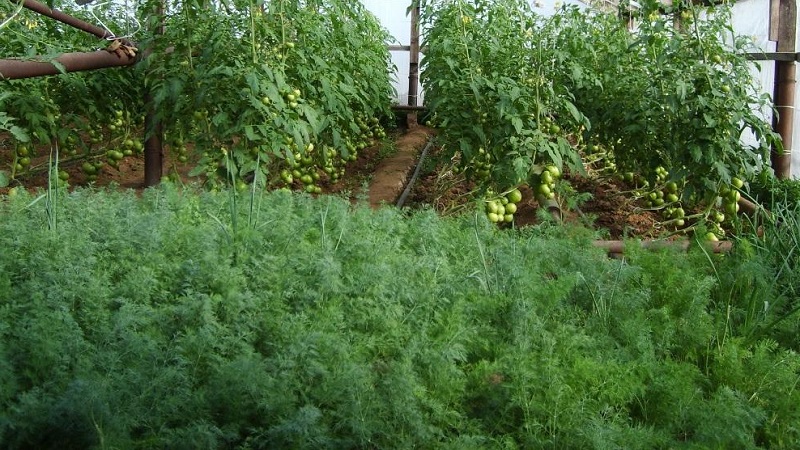A detailed guide to growing dill
Dill is a versatile herb known to every gardener. It is used fresh, dried, frozen. Dill and its umbrellas are kept in the kitchen. Housewives use dill for preservation and pickling, for frying and cooking food. In order not to look for fresh and tasty dill in the store, gardeners grow it on their site - the plant is unpretentious in care, does not require special agrotechnical knowledge and techniques.
The content of the article
Features of dill
Dill saturated useful for the body vitamins and minerals... What is contained in greens and what effect it has on human health, we will consider further.
Chemical composition and trace elements
100 g of the product contains 26 kcal, 3.5 g of protein, 7 g of carbohydrates and 1 g of fat. Greens are rich in iron, calcium, phosphorus, magnesium, zinc and copper. From vitamins - A, B, C, E.

Benefits and harm to the human body
Dill is recommended to use peoplewho have heart problems and are overweight. Greens contain essential oils that have a healing effect and help cleanse the intestinal microflora. Moderate consumption strengthens the immune system, prevents the appearance of vision problems, slows down the growth of bacteria and dangerous microbes. It is recommended to use dill for people with diabetes mellitus: greens normalize blood sugar levels.
Interesting! A mask made of dill and milk whey or sour cream rejuvenates the skin - whitens, removes fine wrinkles and relieves puffiness under the eyes. Also, chopped dill is added to water and frozen - such cosmetic ice cubes get rid of age spots and refresh the skin.
Due to the high content of essential oils, dill is contraindicated for people with hypersensitivity and allergic reactions. It is not recommended to eat it for those who have low blood pressure.
Planting dill
How to plant dill correctly? It is planted on the beds at temperatures from 0 ° C to + 3 ° C. It could be early spring, summer, or fall.
In spring they sow when the snow melts and the soil becomes soft. The soil is moistened with warm water, grooves of 2-3 cm are made, two seeds are placed in each and sprinkled with earth on top. The seedlings are covered with plastic wrap on top - it will protect against frost. The film is removed after 5-7 days.
For summer planting, choose July or August. Seeds are sown in the aisles in the beds with carrots, eggplants, cabbage, tomatoes. It is recommended to plant it along the fence - the greenery prevents the germination of weeds. The planting scheme and procedure is the same as on the garden bed.
When planting greenery in the fall, the harvest is harvested in early spring. It is important to place the seeds in the grooves, water and sprinkle with mulch - a mixture of sand, sawdust, foliage. Mulch protects against crusting, retains moisture and nourishes plant roots.
Outdoor cultivation

It is easy to grow dill, the main thing is to follow the rules for planting in open ground, the regime of watering and feeding. How to care for dill, we will consider further.
Features of planting in the garden
Greens are planted densely - there should not be more than 5 cm distances between the bushes. Any beds for greenery can be chosen - these can be garden paths, aisles, corners of a plot, land along the fence.
They are planted in damp ground, previously dug up, cleared of debris and weeds. The soil should be light and loose, dill prefers sandy loam nutrient soil. Clayy areas are not suitable for planting - dill will not grow.
Important! It is recommended to plant dill in the soil with low acidity. To do this, in the fall, after digging the soil, gardeners bring in ground limestone.
Watering
Greens love moisture, so they water it every 3-4 days. The water temperature for irrigation must be at least 20 ° C. About 500 ml of water is consumed per plant. If the summer is rainy, the amount of water is reduced.
Moisten the soil in the early morning or evening to avoid sunburn and rapid evaporation of water. For convenience, gardeners use a drip system - it saves water, there is no need to waste time and effort on manual watering.
Care features
At the beginning, the formation of the beds is thinned out: the bushes are left at a distance of 3-4 cm from each other, the rest are removed. Thinning stimulates the rapid and complete formation of bushes, the greens become fluffy and tender.
Before thinning, the beds are loosened. Loosening makes the soil lighter and more nutritious, does not allow moisture to quickly evaporate. Together with loosening, weeds are removed - it provokes development diseases and the emergence of insect pests.
Important! Hawthorn aphids may appear on the beds. The pest eats leaves, leaves mucus and plaque on them, which is why the bush dries up and stops developing. For prophylaxis, before planting, the seeds are disinfected with a weak solution of potassium permanganate; during cultivation, they are sprayed with Bordeaux liquid or milk whey.
Fertilizers
For feeding, gardeners use mineral and organic substances. It is recommended to alternate them so that the dill receives a balanced and nutritious diet. Fertilize before watering.
The germination, taste and marketability of dill is positively influenced by:
- nitrogen-containing top dressing - infusion based on mullein, manure or dung;
- saltpeter, ammonia water;
- "Superphosphate" and potassium salt;
- infusion based on yeast and iodine;
- "Ammophos", "Nitrofoska".
How to grow dill without umbrellas
For landing choose bush varieties- Russian size, Dill, Umbrella. Such plants have a lush and voluminous rosette, therefore they are sown in spacious beds. Dill on greens without umbrellas does not bloom for a long time, the harvest is used in cooking and folk medicine.
Seeds are planted not in rows, but in small heaps. A 10 cm hole is dug in the garden bed, disinfected seeds are placed there and sprinkled with moist earth. Care rules are the same as for other varieties.
Growing in hydroponics
This technology means growing crops not on the ground, but in nutrient solutions. The roots are regularly washed with this solution, which moves through a special installation. According to gardeners, the harvest is obtained in 20 days.
Thanks to hydroponics, the plant does not need watering or fertilization - the system does everything by itself. Place the hydroponics on stands in the vegetable garden or hang them in greenhouses. The disadvantage of growing dill in hydroponics is the high cost of the installation.
How to trim properly
The greens are pruned in order to harvest from one garden several times per season. How to cut dill? Gardeners recommend cutting only external shoots. The central leaves, that is, the growth point, do not touch. A new crop will appear from it in 2-3 weeks. Dill is cut 2-3 times during the growing period.
Experienced agronomists recommendations

To increase yields, agricultural technicians are advised to follow these recommendations for caring for dill:
- harden the seeds before planting - place them in the freezer for 2-3 hours every day for one week;
- plant dill annually in different areas;
- before planting, fertilize the ground with manure, add dry sawdust or cleaned river sand;
- do not apply organic and mineral fertilizers at the same time;
- collect greens as they ripen, do not overexpose in the garden.
Conclusion
Dill agrotechnology consists in observing the rules of planting and care. Greens are planted in dachas and garden plots. Dill grows on loose and nutritious soils, the beds are pre-cleaned of debris and dug up. Sprinkle greens with warm water, remove weeds every 10 days and thin out the beds. The dill is cut as it ripens, when the leaves turn deep green and fluffy.